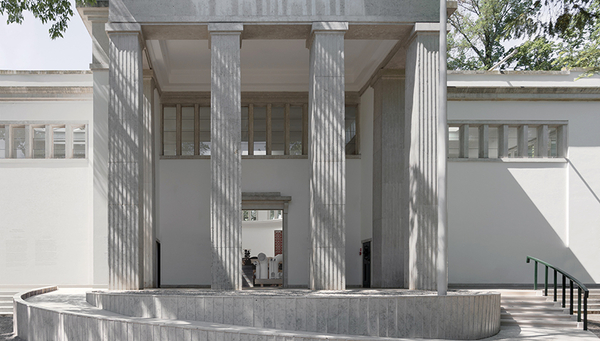News Detail
Eawag technology at the Venice Biennale of Architecture
May 23, 2023 |
The Biennale of Architecture in Venice is one of the world’s most important architecture exhibitions and this year is entitled “Laboratory of the Future”. In addition to the main exhibitions curated by the Ghanaian-Scottish architect Lesley Lokko, around 60 countries are also represented with national contributions, including Switzerland and Germany. The German pavilion is curated by the architecture magazine ARCH+ and the architecture firms Summacumfemmer and Büro Juliane Greb and focuses on the care, renovation and maintenance of architectural heritage under the title “Open for Maintenance / Wegen Umbau geöffnet”. For example, the curators reused material from last year’s Biennale of Art to furnish the five rooms of the pavilion.
Non-flushing toilets
The theme of the recycling economy is also central to the “washroom”, one of the five rooms. It is equipped with a dry separation toilet and a urinal, both newly developed. The toilet from the German manufacturer Finizio does not require water and separates urine and faeces. The urinal was developed by two industrial design graduates from the Basel Academy of Art and Design. They were assisted by Michel Riechmann from the aquatic research institute Eawag, among others. The urinal also works without water and can be used by all genders – hence the name “Urin*all”. Both the dry separation toilet and the urinal are not only exhibits, but can also be used by visitors and pavilion employees.
The “washroom” of the German pavilion with dry separation toilet (photo left) and urinal (photo right).
(Photos: ARCH+ SUMMACUMMFEMMER BÜRO JULIANE GREB)
From urine to plant fertiliser
While the faeces are collected and composted by a regional farmer, the urine – which makes up the largest volume – is treated on site. In the Nutrient Harvester, which was developed by Michel Riechmann together with Kai Udert and other researchers from Eawag’s Process Engineering Department, urine is processed into a concentrated fertiliser directly in the German pavilion. To do this, the urine is first stabilised so that the nitrogen it contains does not escape and no unpleasant odour is emitted. Moreover, pathogens are also killed off during this step. The urine is then dried. From 30 litres of urine, about one kilogram of dry material is produced: a plant fertiliser rich in nutrients such as nitrogen, phosphorus and potassium. It is subsequently used by a farmer and a garden cooperative in the Venice region. “We are thus closing the nutrient cycle locally and at the same time reducing nutrient inputs into water bodies,” says Michel Riechmann.
The Nutrient Harvester extracts around 1 kilogram of dry fertiliser from 30 litres of urine.
(Photo: ARCH+ SUMMACUMMFEMMER BÜRO JULIANE GREB)
Use in areas without water and wastewater networks
The researchers have already tested the Nutrient Harvester in recent years at the SAC’s Legler Hut and in a household without wastewater infrastructure outside the South African city of Durban. “This technology is suitable wherever there are no connections to the water and wastewater networks, be it in regions with little infrastructure or for temporary and mobile uses,” explains Michel Riechmann. Venice and especially the Biennale are a very exciting field of application. “For a city built on water, wastewater disposal is a challenge if the wastewater is not simply to be discharged into the open sewers,” explains Michel Riechmann. And at the Biennale, toilets are in short supply. The pavilions do not have their own toilets and retrofitting infrastructure is difficult under building law. “A modular plug-and-play system like the Nutrient Harvester can fill this gap,” Michel Riechmann is convinced. The researchers therefore now want to bring the Nutrient Harvester to market maturity and are currently launching an Eawag spin-off for this purpose.
Cover picture: The contribution in the German pavilion at the Biennale of Architecture is more than just an exhibition. It wants to provide an action framework for a new building culture. (Photo: ARCH+ SUMMACUMMFEMMER BÜRO JULIANE GREB)




